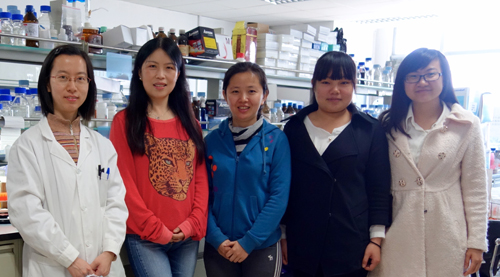Lili Zhang
Title: Lili Zhang Associate Professor
Address:
Telephone/fax:010-64861838
E-mail:zhangll@im.ac.cn
Background
1993-1997 BS in Fermentation Engineering, Dalian Polytechnic University, Dalian, China.
1997-2000 MS in Fermentation Engineering, Dalian Polytechnic University, Dalian, China.
2000-2007 Ph.D. in Genetics, Institute of Microbiology, Chinese Academy of Sciences. Beijing, China.
2008-2014 Postdoctoral Associate in the Section of Infectious Disease, Department of Internal Medicine, Yale University School of Medicine, USA
2014- Associate Professor in the State Key Laboratory of Plant Genomics, Institute of Microbiology, Chinese Academy of Sciences, Beijing, China.
Lab Members
Dr. Yan Huo, Assistant Professor, huoyan1130@126.com
Zhiyu Song, Research Associate, zhiyuamy@163.com
Graduate Students
Qiong Li, 2014-2017
Liying Chen, 2015-2018
Research Interests
This group focuses on the pathogenesis of vector-borne diseases, with important agricultural virus diseases as research model. The main interest is to clarify the virus-vector-host-symbiont interaction network during virus transmission within the insect vector.
The main research areas
I.Plant Virus Diseases
II.Virus-Vector-Host Interactions
III.Microbiota and Endosymbionts in Vector and Host
Publication
[1] Wang J, Zhang Y, Zhao YO, Li M, Zhang L, and Fikrig E. (2013) Anopheles gambiae Circumsporozoite Protein– Binding Protein Facilitates Plasmodium Infection of Mosquito Salivary Glands. J Infect Dis. 208:1161–9
[2] Zhao YO, Kurscheid S, Zhang Y, Zhang L, Loeliger K, and Fikrig E. (2012) Enhanced Survival of Plasmodium-infected Mosquitoes During Starvation. PLoS One 7(7): e40556.
[3] Liu L, Dai J, Zhao YO, Narasimhan S, Yang Y, Zhang L, and Fikrig E. (2012) The Ixodes scapularis JAK-STAT pathway regulates tick antimicrobial peptides, thereby controlling the agent of human granulocytic anaplasmosis. J Infect Dis 206(8): 1233-1241.
[4] Zhang L, Zhang Y, Adusumilli S, Liu L, Narasimhan S, et al. (2011) Molecular Interactions that Enable Movement of the Lyme Disease Agent from the Tick Gut into the Hemolymph. PLoS Pathog 7(6): e1002079.
[5] Wang L, Zhang L, Geng Y, Xi W, Fang R, et al. (2011) XerR, a negative regulator of XccR in Xanthomonas campestris pv. campestris, relieves its repressor function in planta. Cell Res 21: 1131-1142.
[6] Liu L, Narasimhan S, Dai J, Zhang L, Cheng G, et al. (2011) Ixodes scapularis salivary gland protein P11 facilitates migration of Anaplasma phagocytophilum from the tick gut to salivary glands. EMBO Rep 12(11): 1196-203.
[7] Dai J, Narasimhan S, Zhang L, Liu L, Wang P, et al. (2010) Tick Histamine Release Factor Is Critical for Ixodes scapularis Engorgement and Transmission of the Lyme Disease Agent. PLoS Pathog 6(11): e1001205.
[8] Zhang L, Jia Y, Wang L, Fang R (2007) A proline iminopeptidase gene upregulated in planta by a LuxR homologue is essential for pathogenicity of Xanthomonas campestris pv. campestris. Mol Microbiol 65: 121-136.

